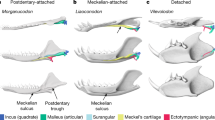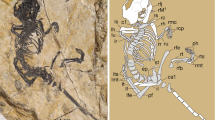Abstract
MULTITUBERCULATES are an extinct, dentally distinctive group of Mesozoic/early Cenozoic mammals of uncertain affinities1. We report here the discovery of a multituberculate ectotympanic bone, associated with the malleus in original life position, from two exquisitely preserved auditory regions. This documents, to our knowledge for the first time, incorporation of the angular and prearticular bones (jaw components in non-mammalian tetrapods) into the middle ear of multituberculates, favouring the hypothesized single origin of the ossicular chain in mammals2,3. Morphology and orientation of these elements are strikingly similar to those of the extant egg-laying platypus and echidnas, suggesting a unique common ancestry of these forms4, an affiliation once generally discredited5–8 but regaining some recent support9,10. The structure of these new multituberculate auditory ossicles, in conjuction with a greatly inflated vestibule and an uncoiled cochlea, implies an ear inefficient for reception of high-frequency airborne vibrations but well suited for bone-conducted hearing.
This is a preview of subscription content, access via your institution
Access options
Subscribe to this journal
Receive 51 print issues and online access
$199.00 per year
only $3.90 per issue
Buy this article
- Purchase on Springer Link
- Instant access to full article PDF
Prices may be subject to local taxes which are calculated during checkout
Similar content being viewed by others
References
Clemens, W. A. & Kielan-Jaworowsk, Z. in Mesozoic Mammals (eds Lillegraven, J. A., Kielan-Jarorowska, Z. & Clemens, W. A.) 99–149 (Univ. California Press, Berkeley, 1979).
Kemp, T. Zool. J. Linn. Soc. 77, 353–384 (1983).
Novacek, M. J. in The Skull Vol. 2 (eds Hanken, J. & Hall, B. K.) 438–545 (Univ. Chicago Press, Chicago, 1993).
Kielan-Jaworowska, Z. Palaeontol. Polonica 25, 5–41 (1971).
Miao, D.-S. Univ. Wyoming Cont. Geol. Sp. Pap. Vol. 4 (1988).
Miao, D.-S. in Mammal Phylogeny Vol. 1 (eds Szalay, F. S., Novacek, M. J. & McKenna, M. C.) 63–74 (Springer, New York, 1993).
Rowe, T. J. Vert. Paleont. 8, 241–264 (1988).
Wible, J. R. J. Vert. Paleont. 11, 1–28 (1991).
Hopson, J. A. & Rougier, G. W. Am. J. Sci. 293, 268–299 (1993).
Wible, J. R. & Hopson, J. A. in Mammal Phylogeny Vol. 1 (eds Szalay, F. S., Novacek, M. J. & McKenna, M. C.) 45–62 (Springer, New York, 1993).
De Beer, G. R. The Development of the Vertebrate Skull (Clarendon, Oxford, 1937).
Miao, D.-S. & Lillegraven, J. A. Nat. geogr. Res. 2, 500–507 (1986).
Henson, O. W. Jr Univ. Kansas Sci. Bull. 42, 151–255 (1961).
Zeller, U. in Mammal Phylogeny Vol. 1 (eds Szalay, F. S., Novacek, M. J. & McKenna, M. C.) 95–107 (Springer, New York, 1993).
Presley, R. Symp. Zool. Soc. Lond. 52, 127–152 (1984).
Fleisher, G. V. Säug. Mitt. 21, 131–239 (1973).
Allin, E. F. & Hopson, J. A. in The Evolutionary Biology of Hearing (eds Webster, D. B., Fay, R. R. & Popper, A. N.) 587–614 (Springer, New York, 1992).
Kermack, K. A., Mussett, F. & Rigney, H. W. Zool. J. Linn. Soc. 53, 87–175 (1973).
Luo, Z.-X. & Crompton, A. W. J. Vert. Paleont. 14, 341–374 (1994).
Kielan-Jaworowska, Z., Crompton, A. W. & Jenkins, F. A. Jr Nature 326, 871–873 (1987).
Aitkin, L. M. & Johnstone, B. M. J. exp. Zool. 180, 245–250 (1972).
Gates, G. R., Saunders, J. C., Bock, G. R., Aitkin, L. M. & Elliott, M. A. J. acoust. Soc. Am. 56, 152–156 (1974).
Kermack, K. A. & Mussett, F. Acta Palaeont. Polonica 28, 147–158 (1983).
Luo, Z.-X. & Ketten, D. R. J. Vert. Paleont. 11, 220–228 (1991).
Békésy, G. von Experiments in Hearing (McGraw-Hill, New York, 1960).
Kielan-Jaworowska, Z. & Qi, T. Vert. PalAsiatica 28, 81–94 (1990).
Griffiths, M. The Biology of the Monotremes (Academic, New York, 1978).
McKenna, M. C. in Molecules and Morphology in Evolution: Conflict or Compromise? (ed. Patterson, C.) 55–93 (Cambridge Univ. Press, Cambridge, 1987).
Kielan-Jaworowska, Z. & Gambaryan, P. P. Fossils Strata 36, 1–92 (1994).
Meng, J. & Fox, R. C. Zool. J. Linn. Soc. 114 (in the press).
Author information
Authors and Affiliations
Rights and permissions
About this article
Cite this article
Meng, J., Wyss, A. Monotreme affinities and low-frequency hearing suggested by multituberculate ear. Nature 377, 141–144 (1995). https://doi.org/10.1038/377141a0
Received:
Accepted:
Issue Date:
DOI: https://doi.org/10.1038/377141a0
This article is cited by
-
Petrosal morphology of the Early Cretaceous triconodontid Astroconodon from the Cloverly Formation (Montana, USA)
Journal of Mammalian Evolution (2023)
-
New Skull Material of Taeniolabis taoensis (Multituberculata, Taeniolabididae) from the Early Paleocene (Danian) of the Denver Basin, Colorado
Journal of Mammalian Evolution (2021)
-
A Jurassic gliding euharamiyidan mammal with an ear of five auditory bones
Nature (2017)
-
Resolving the evolution of the mammalian middle ear using Bayesian inference
Frontiers in Zoology (2016)
-
Digital Reconstruction of the Otic Region and Inner Ear of the Non-Mammalian Cynodont Brasilitherium riograndensis (Late Triassic, Brazil) and Its Relevance to the Evolution of the Mammalian Ear
Journal of Mammalian Evolution (2013)
Comments
By submitting a comment you agree to abide by our Terms and Community Guidelines. If you find something abusive or that does not comply with our terms or guidelines please flag it as inappropriate.



